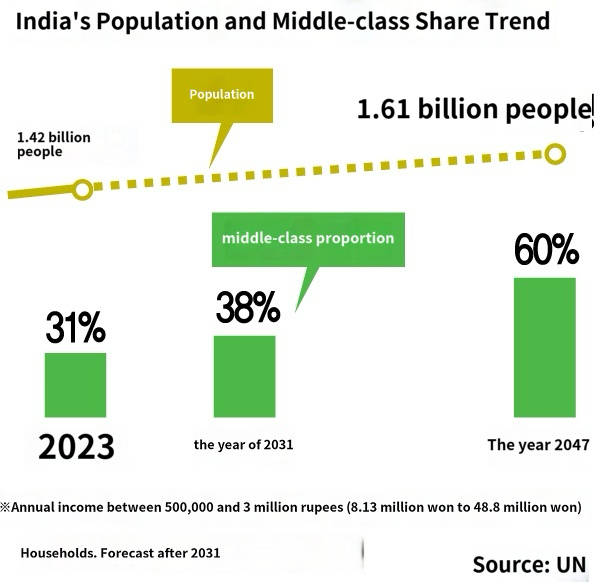
“India has a population of 1.4 billion and 26% of them are young people aged 15-26. The average per capita income is less than $3,000, but we are growing 7% every year and we are seeing a surge in internet usage. All these changes will drive growth in the semiconductor industry.”
When asked why he is confident about India’s success in semiconductors, Shafali Jain, regional director for multinational corporations at ICICI Bank, a major Indian bank, told the Seoul Economic Daily, he cited “India’s strong consumer market.” Analysts say that India’s growing domestic demand alone is sufficient to be a driving force for the industry. According to McKinsey, a global consulting firm, the Indian government predicts that the global semiconductor market will grow to a scale of 1 trillion U.S. dollars by 2030, with the global semiconductor market expected to grow by 16 percent per annum to reach 109 billion dollars by 2030. Currently, India imports more than 95 percent of its semiconductors. In other words, the amount of imports can be huge even if it is converted to domestic demand.
It is not just semiconductors. India, which has established itself as the world’s largest population after China, is considered the most attractive market for global companies. Recently, news has been reported that Apple, the world’s No. 1 smartphone maker, will manufacture some of its latest iPhone 16 models in India, which analysts say is a move aimed at preoccupying the burgeoning Indian smartphone market. Apple opened two flagship stores in India last year, which is also seen as a move aimed at targeting domestic demand. According to market research firm Strategy Analytics, the number of smartphones sold in India last year amounted to 138.1 million, the second largest market in the world after China (261.7 million). What’s more expectation is future growth. Analysts say that if income increases, India will steadily follow the path of increasing middle-class people and growing domestic consumer market. Price, an Indian non-profit research group, predicts that 60 percent of India’s population, or about 800 million, will become middle-class by 2047.
Vietnam and Malaysia are mentioned as markets that global companies are eyeing due to the young population leading to high economic growth. In particular, Vietnam’s domestic consumption growth rate, led by a population of more than 100 million, has reached an annual average of 7.0% over the past decade. In addition, 32.7% of the population is young people aged 25 to 44, and the population is expected to increase by 2050. Thailand and Indonesia are drawing attention as the electric vehicle market is growing rapidly in line with the government’s industrial promotion measures. The Thai government has set a goal of ensuring that the production of pollution-free vehicles will account for 30% of all automobile production by 2030, and the penetration rate of electric vehicles has increased from 1% in 2021 to about 11% in 2023. Indonesia, the world’s fourth-largest population with more than 270 million people and the world’s largest nickel producer, is attracting investment through subsidies and tax cuts to foster the manufacturing of electric vehicles and batteries. It has also set an ambitious goal of 100% conversion to electric vehicles by 2050. Indonesia’s electric vehicle penetration rate is still in its infancy at 1.7% in 2023, but expectations are growing that the electric vehicle market will grow rapidly along with income growth and the expansion of the middle class.
JULIE KIM
US ASIA JOURNAL



